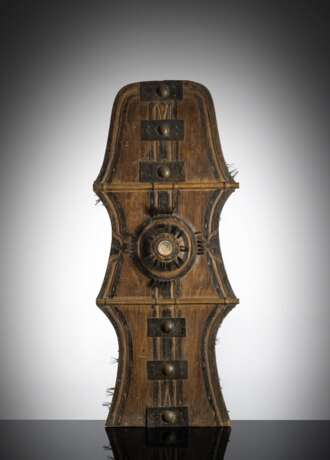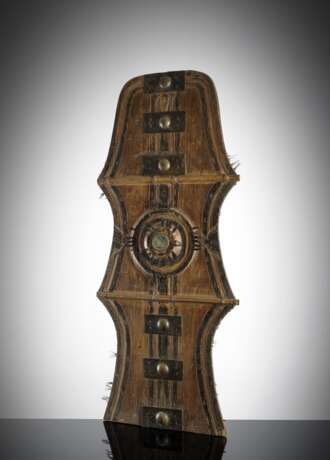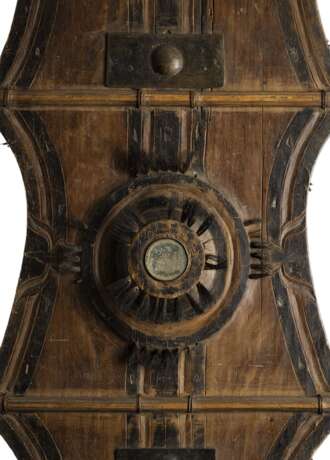ID 1218035
Lot 1518 | Schild "Kalasag" aus Holz
Estimate value
€ 1 500 – 2 500
108 x 45 cm
Dieser im Profil flach-rechteckige, monumental wirkende Schild besteht aus mittelhartem Holz und ist rechteckigen gebuckelten Metallelementen und zwei horizontal verlaufenden Rattanstäben verstärkt. In der Mitte sitzt der erhabene runde Schildbuckel, in dessen Zentrum sich eine Scheibe aus Spiegelglas befindet. Strahlenartig gehen von diesem Buckel Büschel aus schwarzem Ziegenhaar aus, was dem Ganzen den Eindruck eines starrenden Auges verleiht. Die Scheibe weist aufgrund des spiegelnden Effektes schädliche Einflüsse und böse Geister ab. Längs verlaufen geometrische Kannelierungen. Der Rand des Schildes ist mehrfach elegant tailliert. Auch hier sind Haarbüschel eingesetzt, die nur noch rudimentär erhalten sind. Der Schild ist teilweise schwarz gefasst. Die Basis ist gerade. Die Schilde der Lumad-Ethnien unterscheiden sich deutlich von den Rundschilden des-indo-persischen Typs der benachbarten muslimischen „Moro“ (Tausug, Illanún, Yaka und anderen). Derartige Schilde sind spezifisch für die Lumad-Kulturen auf Mindanao, vor allem für die Bagobo, eine der größten nicht-islamisierten Ethnien auf Mindanao. Lumad ist ein Cebuano-Begriff für „Ureinwohner“ oder „indigen“. Es ist die Kurzform von katawang Lumad und wurde als Selbstbeschreibung 1986 von der Lumad Mindanaw Peoples Federation (LMPF) eingeführt. Er bezeichnet die indigenen Völker auf Mindanao, die nicht christianisiert oder islamisiert wurden und noch ihre alten Traditionen pflegen. Dazu zählen unter anderem folgende Gruppen: Bilaan, Mamanwa, Manobo, Manobo Bilit, Manobo Tasaday, Mandaya, Mansaka, Kalagan, T'boli, Subanu und Tiruray. Viele dieser Ethnien sind für ihr hervorragendes Metallhandwerk bekannt, vor allem für den Gelbguss. Der Reis-Anbau ist bei den Lumad mit religiösen Überzeugungen und Praktiken verbunden. Wenn Orion im Dezember am Himmel erscheint, ist dies das Signal für die Feier des großen Jahresopfers und Gebete an die landwirtschaftlichen Kulturheroen Manama und Taragomi. Früher war zu diesem Anlass auch die rituelle Kriegsführung mit Kopfjagd erforderlich, was aufgrund indisch-hinduistischer Einflüsse schon lange unüblich ist. Gleichwohl sind Schilde und Waffen noch wichtige Symbole der Fruchtbarkeit.
Lit.: Hayase, S. (2007). Mindanao Ethnohistory Beyond Nations: Maguindanao, Sangir, and Bagobo Societies in East Maritime Southeast Asia. Hawaii. - Felix, L. E. (2004). Exploring the Indigenous Local Governance of Manobo Tribes in Mindanao (PDF). Philippine Journal of Public Administration 48XLVIII (1 & 2) - Barrows, D. P. (1910). The Negrito and allied types in the Philippines. American Anthropologist. 12 - Ulindang, F. (2021): Lumad in Mindanao. National Commission for Culture and Arts, Philippines. - De Jong, R. (2010). The last tribes of Mindanao, the Bagobo, the New People. In: Things Asian 2019.
Aus einer alten deutschen Privatsammlung, seit den 1950er Jahren gesammelt - Altersspuren, partiell kleine Best.
| Auction house category: | Ethnographic tribal art |
|---|
| Auction house category: | Ethnographic tribal art |
|---|
| Address of auction |
Nagel Auktionen GmbH Neckarstrasse 189 - 191 70190 Stuttgart Germany | ||||||||||||||
|---|---|---|---|---|---|---|---|---|---|---|---|---|---|---|---|
| Preview | |||||||||||||||
| Phone | +49 (0)711 649 690 | ||||||||||||||
| Fax | +49 (0)711 649 69696 | ||||||||||||||
| Buyer Premium | 29,5% | ||||||||||||||
| Conditions of purchase | Conditions of purchase | ||||||||||||||
| Business hours | Business hours
|





